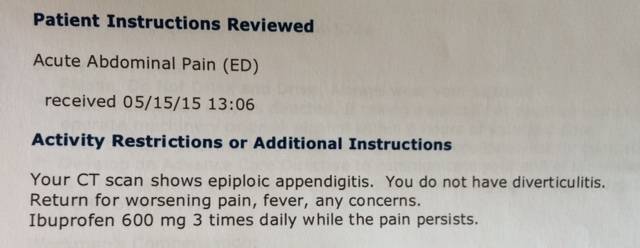Followup Note: In the story below, it turns out the radiologist was wrong. What I actually had was diverticulosis.
Continuing along with my great diverticulitis adventure (or, “How I spent the Spring of 2015 in Colorado”), yesterday I took another trip to the ER, had another CT scan, and to my great surprise I found out that I don’t have diverticulitis, but instead I have something called Epiploic appendagitis:

Epiploic appendagitis
As a patient, I can tell you that epiploic appendagitis feels a lot like appendicitis -- it feels like your colon/intestines are going to pop like a balloon in a very specific spot -- but in my case it is on the lower-left side of my abdomen, which is where diverticulitis pain is often located.
This is how Wikipedia describes epiploic appendagitis:
“Epiploic appendagitis (EA) is an uncommon, benign, non-surgical, self-limiting inflammatory process of the epiploic appendices. Epiploic appendices are small, fat-filled sacs or finger-like projections along the surface of the upper and lower colon and rectum. They may become acutely inflamed as a result of torsion (twisting) or venous thrombosis. The inflammation causes pain, often described as sharp or stabbing, located on the left, right, or central regions of the abdomen. There is sometimes nausea and vomiting. The symptoms may mimic those of acute appendicitis, diverticulitis, or cholecystitis.”
Another website named radiopaedia.com adds these descriptions:
“Clinically patients present with abdominal pain and guarding. It is essentially indistinguishable from diverticulitis and acute appendicitis (depending on location) and although an uncommon condition, it accounts for up to 7% of cases of suspected diverticulitis ... The pathogenesis is thought to be due to torsion of a large and pedunculated appendage epiploicae, or spontaneous thrombosis of the venous outflow, resulting in ischaemia and necrosis.”
At the moment the “ischaemia (lack of blood flow) and necrosis (tissue/organ death)” are freaking me out, but the doctors say it’s okay. I’ll add more information here about that as I learn about it.



